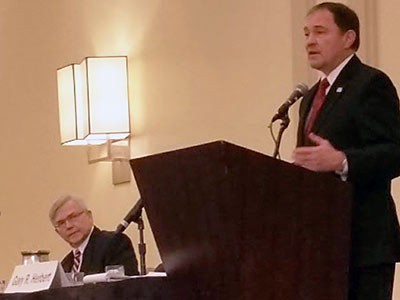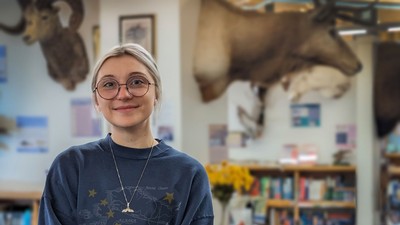Recorded Proceedings of USU-led Sagebrush Conference Now Available
Free, recording proceedings of the USU-led 2016 Sagebrush Ecosystem Conservation Conference are now available online at sagegrouseconference2016.org. Courtesy U.S. Fish and Wildlife Service.
Free, recorded proceedings of the 2016 Sagebrush Ecosystem Conservation Conference: All Lands, All Hands held Feb. 23-26, in Salt Lake City, are now available online.
The gathering, addressed by U.S. Department of Interior Assistant Secretary Janice Schneider and Utah Gov. Gary Herbert, drew more than 500 attendees and an additional 300 attendees participating through Web streaming. Schneider said conservation of the Great Basin ecosystem is a tremendous, and sometimes contentious, challenge, but Utah’s cooperative partnerships, led by researchers in Utah State University’s Quinney College of Natural Resources and USU Extension, are a stellar model for the entire nation.
“This is really an unprecedented undertaking,” said Schneider during the gathering’s opening session Feb. 23. “We are working across a whole landscape across the West and using the best available science and translating that into action to protect, restore and preserve the landscape. The key takeaway on why Utah has been so successful is the continued level of collaboration and coordination that we have seen.”
The region-wide conference, hosted by USU, the Great Basin Consortium and the Western Association of Fish and Wildlife Agencies, was co-organized by USU Ecology Center scholars Mark Brunson, professor in USU’s Department of Environment and Society and Terry Messmer, professor in USU’s Department of Wildland Resources and USU Extension wildlife management specialist.
Utah Gov. Gary Herbert, who spoke Feb. 25 at the gathering, praised USU’s efforts specifically, citing the university’s leadership of statewide sage-grouse conservation efforts for more than 20 years.
“We care about the greater sage-grouse, we care about its habitat,” the governor said. “Since 2005, Utah has spent more than $130 million to enhance sagebrush habitats for sage-grouse.”
The conference took place just five months after Interior Secretary Sally Jewell announced the U.S. Fish and Wildlife Service’s decision not to list Greater sage-grouse under the Endangered Species Act. In his conference address, Herbert said the decision is a testament to the unprecedented efforts of Utah and other western states to conserve sagebrush species.
Messmer says he’s pleased with the gathering and notes more than 80 percent of the participants were from outside Utah.
“The conference fills an emerging void regarding information about the conservation and management of the sagebrush ecosystem,” says Messmer, Quinney Professor for Wildlife Conflict Management and director of Utah’s Community-Based Conservation Program. “It also opens a new dialogue between managers, scientists, landowners and other stakeholders regarding the role of science in management.”
Messmer says more than a dozen USU faculty and students presented research at the gathering and a number of the conference’s keynote speakers were USU alumni. He also praised USU student volunteers, who “were invaluable to the success of the conference.”
USU’s efforts had made a tremendous impact on Utah and other areas across the West, he says. “Gathering diverse groups together, bringing the best science toward solutions, sorting out differences and committing to shared goals is the aim of our efforts. We have a lot of work ahead of us but, with this conference, we accomplished our purpose.”
Related links:
- “USU Key Player in Historic Conservation Effort for Greater Sage-grouse,” Utah State Today
- “Western Extension Directors Laud USU-led Community-Based Conservation,” Utah State Today
- USU Department of Environment and Society
- USU Department of Wildland Resources
- USU Quinney College of Natural Resources
- USU Extension Community-Based Conservation
- Utah Agricultural Experiment Station
- Great Basin Consortium
Contact: Terry Messmer, 435-797-3975, terry.messmer@usu.edu
Contact: Mark Brunson, 435-797-2458, mark.brunson@usu.edu
Writer: Mary-Ann Muffoletto, 435-797-3517, maryann.muffoletto@usu.edu
Gov. Gary Herbert, right, addresses the 2016 Sagebrush Ecosystem Conference in Salt Lake City, as USU conference chair Terry Messmer, left, looks on. Herbert praised USU's leadership efforts in conservation. Photo by Brandon Flack/USU.
Comments and questions regarding this article may be directed to the contact person listed on this page.








